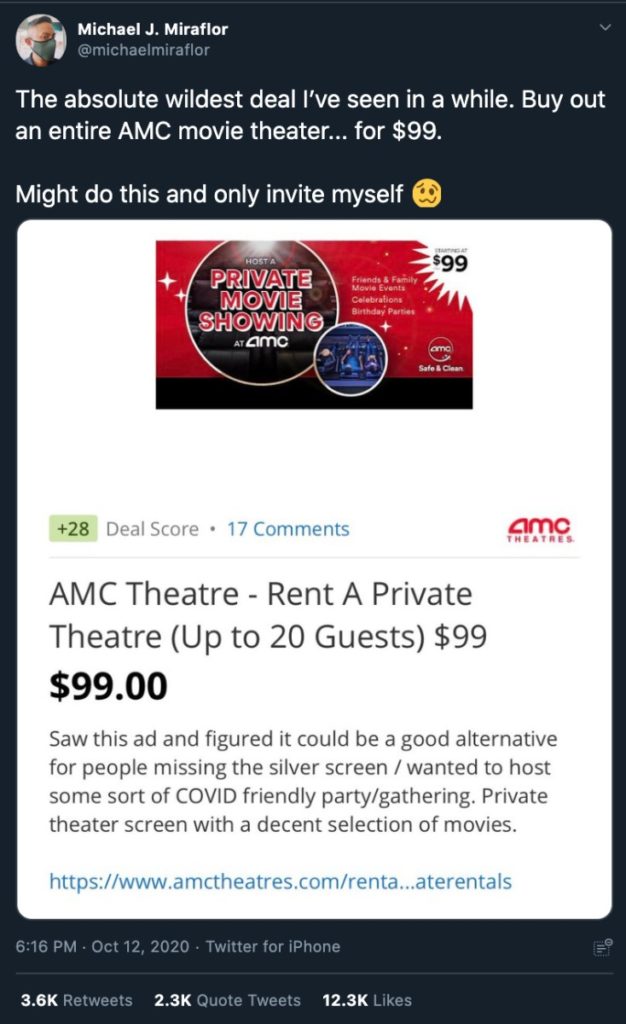This content originally appeared October 15, 2020 as part of the Future of Marketing weekly email series. Subscribe here.
The incentive theory proposes that people will be more motivated to do something if it leads to rewards – but unnecessary rewards can have negative consequences.
“When you ask people to do something for you, they will often ask why. When you ask people to give you money, they will always ask why,” shared Alexander Santo. “The job of a marketer is to begin answering that question before the customer or client can ask.”
If you want to get people to advocate for you, start by asking yourself why they should buy from you in the first place.
Incentivize user-generated content
As predicted, holiday promos came early this year (and movies are quick to follow).
Facebook launched #BuyBlackFriday, Shopify is supporting small business with UGC, and Best Buy kicked off its early Black Friday deals – right on time to compete with Prime Day.
The #AppleEvent also took place recently, creating a flood of user-generated content (UGC) for Apple to analyze sentiment, collect feedback, and potentially capitalize on.
Disney, on the other hand, is shifting gears by skipping theatres to stream movies faster than we’ve ever seen before. And AMC theatres are offering private rooms for up to 20 people for $99.
But let’s back up. Check out the impressive engagement on the tweet Marketing Consultant, Michael Miraflor, shared above:
Upon studying the engagement on Nathan Apodaca’s Ocean Spray TikTok video – and now Miraflor’s tweet – this proves that content created by real people (UGC) is the most powerful and trusted content (and impacts revenue).
Engage with intention
A brand that consistently aligns its values with intentional marketing can turn people into brand advocates, but it comes down to consistency and giving people what they want.
“We want to give something to this audience,” said Phil Hruska, manager of media strategy at Honda in America. “We don’t want to just slap a logo and call it a day — we want to present ourselves in a meaningful way that gives something to the fans.”
While Honda and Nestlé build trust within the Esports community, Delta tweeted a question that sparked a gold mine for social listening and UGC.
Delta can now repurpose and analyze responses to learn from its fans, their desires, and position the company for rising expectations.
Tip: Use social media as a tool to listen and understand your audience’s needs and motivations. Ask questions, engage with other people’s content, and be helpful.
Self-promotion will only get you so far.
What we’re learning…
- How to capitalize on short-form video UGC [Forbes]
- Many companies are pushing remote work until (at least) Summer 2021 [NY Times]
- 7 benefits of social media you can’t afford to lose [Social Media Today]
- We interviewed Brianne Fleming, Marketing Instructor at the University of Florida and Host of #PopChat [Future of Marketing]
- Ocean Spray is everywhere! TikTok repurposed Ocean Spray’s UGC and turned it into an ad [YouTube]
- … And our *very talented* teammate took inspiration from Ocean Spray and added his unique spin [TINT]
#brandcrush: Canon
Each week in #brandcrush we highlight exceptional brands that are channeling their customers’ voice to connect more authentically with their audience.
Canon UK builds trust across specific user touchpoints – its blog, social media, a microsite – sharing inspiring stories and interviews with creators and photographers along the way.
Canon’s Instagram is loaded with captivating UGC, where it pulls adventurous images social media users upload and tag with #LiveForTheStory.
And then, Canon reshares select UGC on its feed, credits the creators (hint, hint), and turns this content into how-to posts, stories, and questions for its fans.
Bonus points for promoting the Canon equipment people used to capture these images – without feeling like an ad.
In its latest #FreeYourStory photo contest, Canon also asked its fans to upload photos (or video) to a custom microsite with a creative brief to follow: ‘The Mirror Selfie’ and ‘Forced Perspective.’
This UGC was then reshared in that same microsite in a UGC gallery (i.e. social proof).
Select winners were to be featured on social media – and receive free camera equipment and a masterclass with a professional photographer chosen by Canon.
And what brand advocate wouldn’t want that?







